National park Altyn Emel
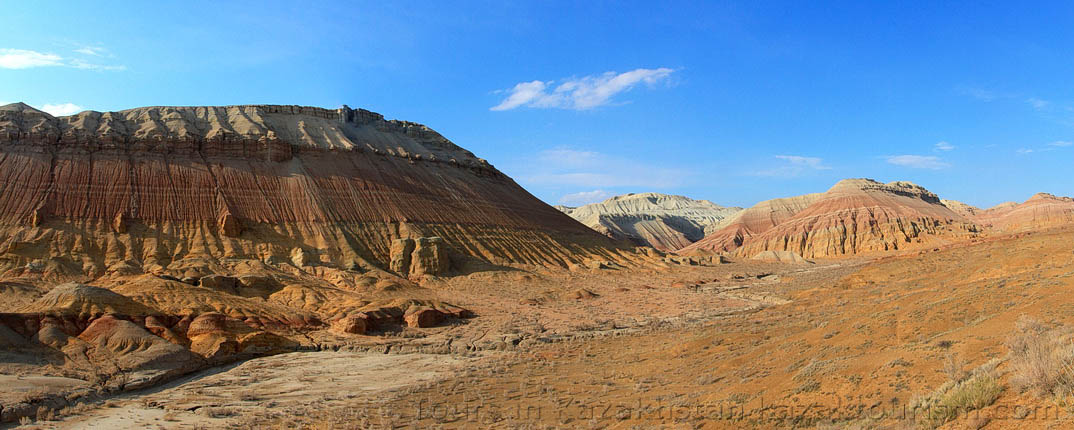
Two days tour: Altyn-Emel national park
Three days tour: Altyn-Emel national park. Kolsay, Kaindy lakes.
Four days tour: 2 National parks - From desert to mountains
|
Semirechje
(seven rivers) is characterized by the variety of landscapes. Between
the mountain ranges of Djungary and Tien Shan winds the blue ribbon
of the Ili river, the chief river of Semirechye (literally –seven
rivers land, a territory name in the South-East of Kazakhstan). The
valley of the Ili river and its tributaries is remarkable for its
spectacular views and landscapes. In the middle course of Ili, on its
right bank, there is the national park Altyn-Emel. All the wealth of
Semirechye nature is collected in this park.The state national park
Altyn-Emel was established by the statement of the Republic
Kazakhstan’s government (#460 dated by the 10 April 1996) based on
the Kapchagay state hunting sector. It is located in the territories
of Kerbulak and Panfilov districts of Almaty. The central farm is in
Basshi village which is 250 kilometers far from Almaty. The total
park area is 459620 hectares. Altyn-Emel stretches for 30 kilometers
from the south to the north and more than for 200 kilometers from the
east to the west.Translated from Mongolian Altyn-Emel means "the
golden saddle”. There is a legend that the Genghis Khan army moved
through this valley to occupy the Middle Asia in 1219. The great
Mongol leader exclaimed "the golden saddle!” when he saw the
mountains covered with the grass yellowed at sunset. Indeed, looking
closely at the Altyn-Emel pass one could agree that its form
resembles a saddle. There are different kinds of landscapes in the
Altyn Emel area including sand deserts and arid mountains.You can
find their more detailed description below.Altyn-Emel is famous for
its natural and historical significant sites.
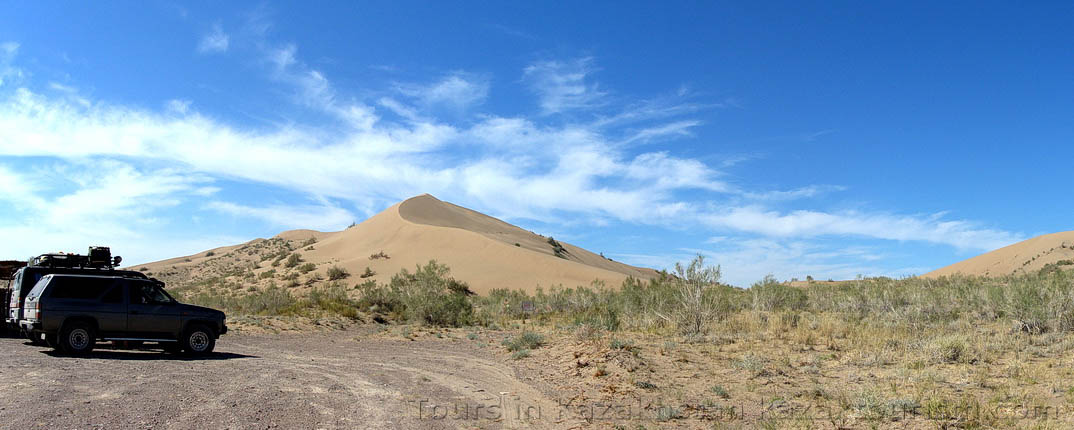 The Singing Barkhan (also called Singing Dune) is a sandy ridge that is about 100
metres high and extended for three kilometers in the middle of the
stony desert.The barkhan is called "singing” because of the deep
vibrating sound it sometimes produces and reminding the flying
plane’s sound or to the pipe organ’s sounding. The "songs” of
the Singing Barkhan can be heard even for several kilometers. The
sound is produced by many sand grains rubbing against each other: by
the light wind the hardly audible squeaking is produced; the gusts of
wind create a more intense and significant sounds like weird roaring
or humming. But even if there is no wind at all one can hear
barkhan’s melody. The footsteps on the barkhan’s surface will
cause the friction of the grains of sand creating the unusual
sounding. Despite of the sand fluctuation and the strong winds the
barkhan doesn’t move and remains at the same place on the
Altyn-Emel’s territory for several thousands of years. The local
folk legends say that the great Genghis Khan and his warriors are
buried under the sand dunes and when the Khan’s soul "exhausted
by the spiritual unrest narrates his heroic stories to the
descendants” then the sand dunes sing.Aktau are the chalky
mountains created by the deposits of the Cenozoic era. The mountains
consist of the gypsified clay in which the winds and the water shaped
some fantastic canyons. This rock massif is characterized by the
absence of flora, so it resembles the fantastic moon landscapes. The
mountains are bald and have steep slopes; the significant partition
is determined by the intense erosion caused by the rainfalls and
mudflows. The Singing Barkhan (also called Singing Dune) is a sandy ridge that is about 100
metres high and extended for three kilometers in the middle of the
stony desert.The barkhan is called "singing” because of the deep
vibrating sound it sometimes produces and reminding the flying
plane’s sound or to the pipe organ’s sounding. The "songs” of
the Singing Barkhan can be heard even for several kilometers. The
sound is produced by many sand grains rubbing against each other: by
the light wind the hardly audible squeaking is produced; the gusts of
wind create a more intense and significant sounds like weird roaring
or humming. But even if there is no wind at all one can hear
barkhan’s melody. The footsteps on the barkhan’s surface will
cause the friction of the grains of sand creating the unusual
sounding. Despite of the sand fluctuation and the strong winds the
barkhan doesn’t move and remains at the same place on the
Altyn-Emel’s territory for several thousands of years. The local
folk legends say that the great Genghis Khan and his warriors are
buried under the sand dunes and when the Khan’s soul "exhausted
by the spiritual unrest narrates his heroic stories to the
descendants” then the sand dunes sing.Aktau are the chalky
mountains created by the deposits of the Cenozoic era. The mountains
consist of the gypsified clay in which the winds and the water shaped
some fantastic canyons. This rock massif is characterized by the
absence of flora, so it resembles the fantastic moon landscapes. The
mountains are bald and have steep slopes; the significant partition
is determined by the intense erosion caused by the rainfalls and
mudflows. 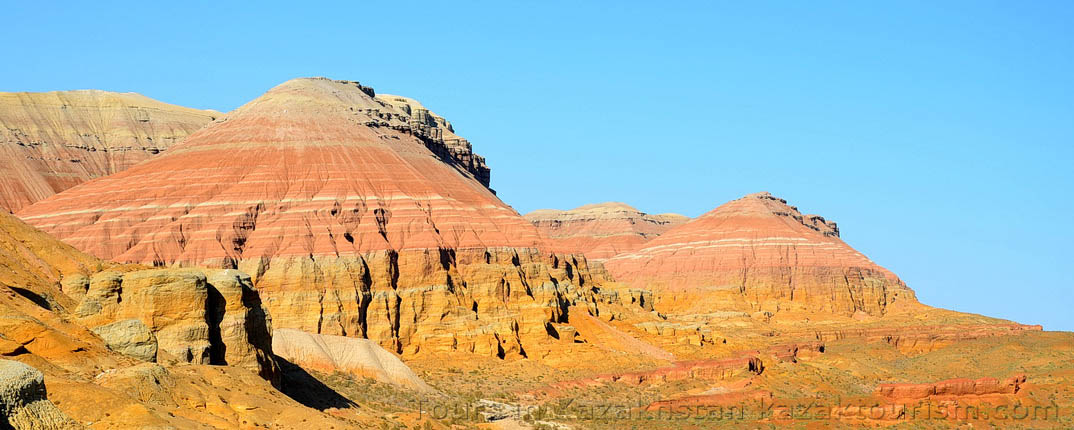 A A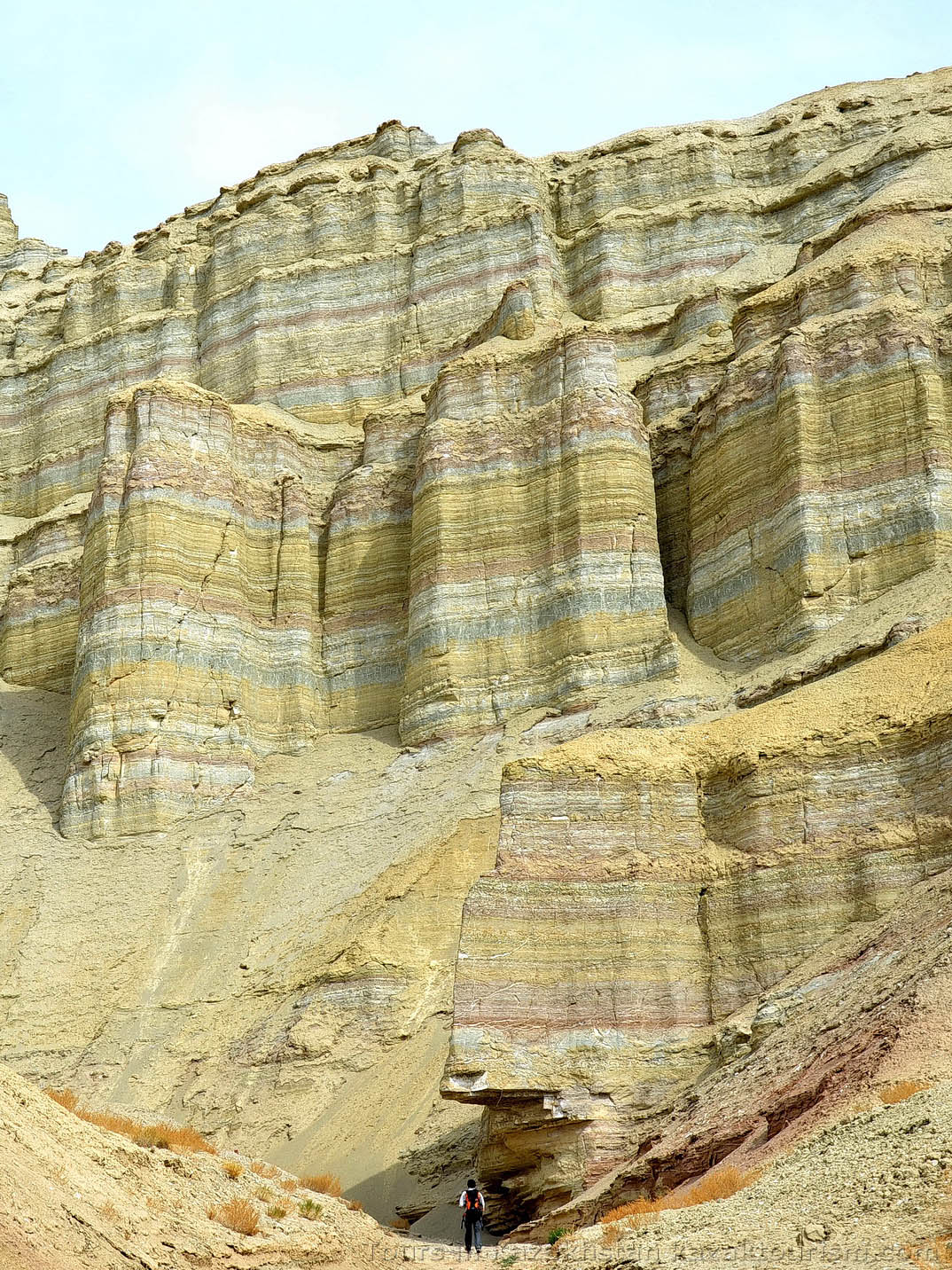 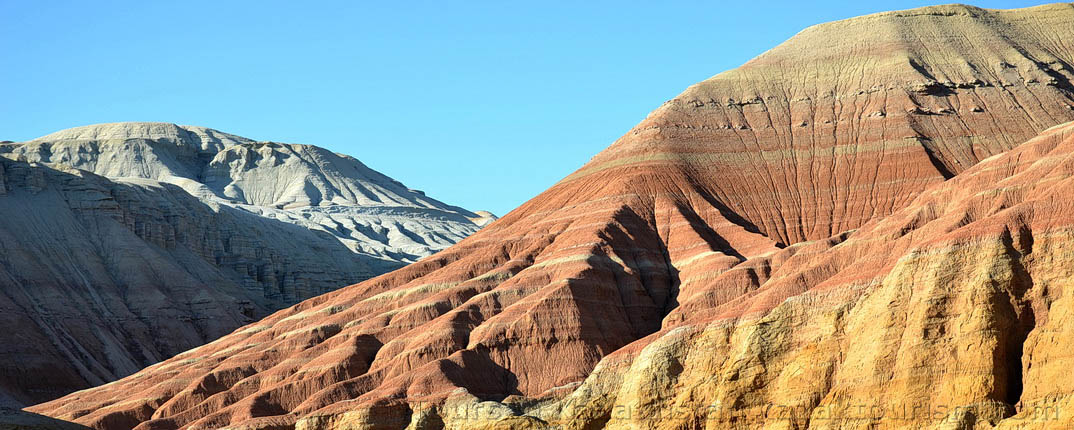 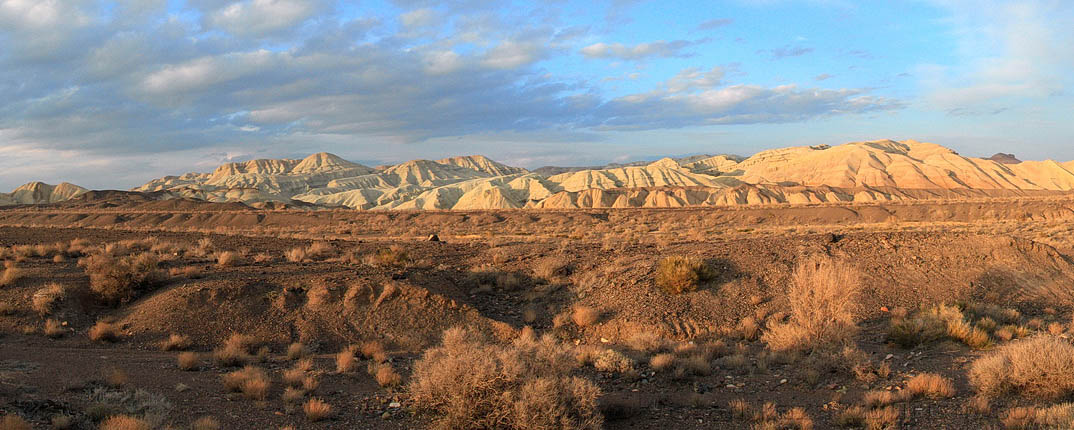 ktau massif is the unique paleontological deposit that is
worldwide famous. 56 species of the early Miocene flora were found
here: pine tree, fir, birch, alder, oak, nut, chestnut, linden,
hackberry, pistachio, ailanto and many others. The remains of the
ancient animals are preserved perfectly in the lake deposits of the
Paleogene-Neogene (crocodile, tortoise, the giant rhinoceros and some
primitive predators) aged 25-30 million years as estimated. Near to
the Aktau there are Katutau mountains.Katutau mountains (1630 meters
above sea level) stretch from the south-west to the north-east. It is
a not wide mountain range, hilly and steeply-sloping with the
plateau-like tops. The slopes are split by many waterless passes. The
red clays and blue-grey limestone sand rocks of the Tertiary show up
like bright ribbons. "Katutau” means "severe mountains”. In
Permian (approximately 240 millions of years ago) there were two big
acting volcanos. The mountains are formed by lava and some associated
volcanic rocks. In the mountain area there are some inputs of the
radiating dikes (a dike is an earth split filled with magma. The
split is formed by the earth movements like earthquakes or volcano
eruptions). Some dikes are 8 kilometers long. In the northern part of
the Katutau and Aktau there are some sedimentary bed rocks of the
ancient ocean Tethys. Impacted by the above mentioned natural factors
the rocks formed some spectacular shapes and landscapes.The Small and
Big Kalkans are the Paleozoic range of the exposed type characterized
by the intense destruction of the rocks. The mountains are not high
and not very remarkable. They are located in the southern part of the
National park and there is nothing special about them. But between
those mountains there is the worldwide famous Singing Barkhan, also
called the Singing Sand Dunes, the pearl of Altyn-Emel. ktau massif is the unique paleontological deposit that is
worldwide famous. 56 species of the early Miocene flora were found
here: pine tree, fir, birch, alder, oak, nut, chestnut, linden,
hackberry, pistachio, ailanto and many others. The remains of the
ancient animals are preserved perfectly in the lake deposits of the
Paleogene-Neogene (crocodile, tortoise, the giant rhinoceros and some
primitive predators) aged 25-30 million years as estimated. Near to
the Aktau there are Katutau mountains.Katutau mountains (1630 meters
above sea level) stretch from the south-west to the north-east. It is
a not wide mountain range, hilly and steeply-sloping with the
plateau-like tops. The slopes are split by many waterless passes. The
red clays and blue-grey limestone sand rocks of the Tertiary show up
like bright ribbons. "Katutau” means "severe mountains”. In
Permian (approximately 240 millions of years ago) there were two big
acting volcanos. The mountains are formed by lava and some associated
volcanic rocks. In the mountain area there are some inputs of the
radiating dikes (a dike is an earth split filled with magma. The
split is formed by the earth movements like earthquakes or volcano
eruptions). Some dikes are 8 kilometers long. In the northern part of
the Katutau and Aktau there are some sedimentary bed rocks of the
ancient ocean Tethys. Impacted by the above mentioned natural factors
the rocks formed some spectacular shapes and landscapes.The Small and
Big Kalkans are the Paleozoic range of the exposed type characterized
by the intense destruction of the rocks. The mountains are not high
and not very remarkable. They are located in the southern part of the
National park and there is nothing special about them. But between
those mountains there is the worldwide famous Singing Barkhan, also
called the Singing Sand Dunes, the pearl of Altyn-Emel.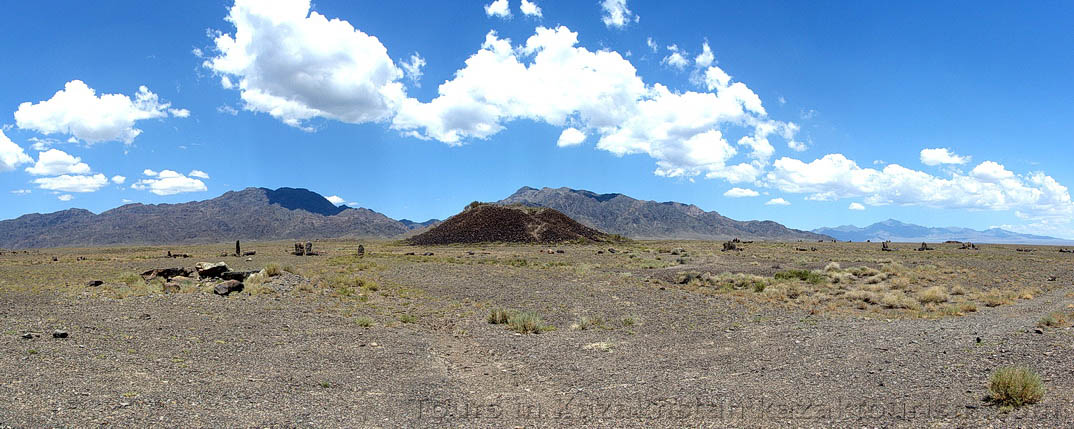 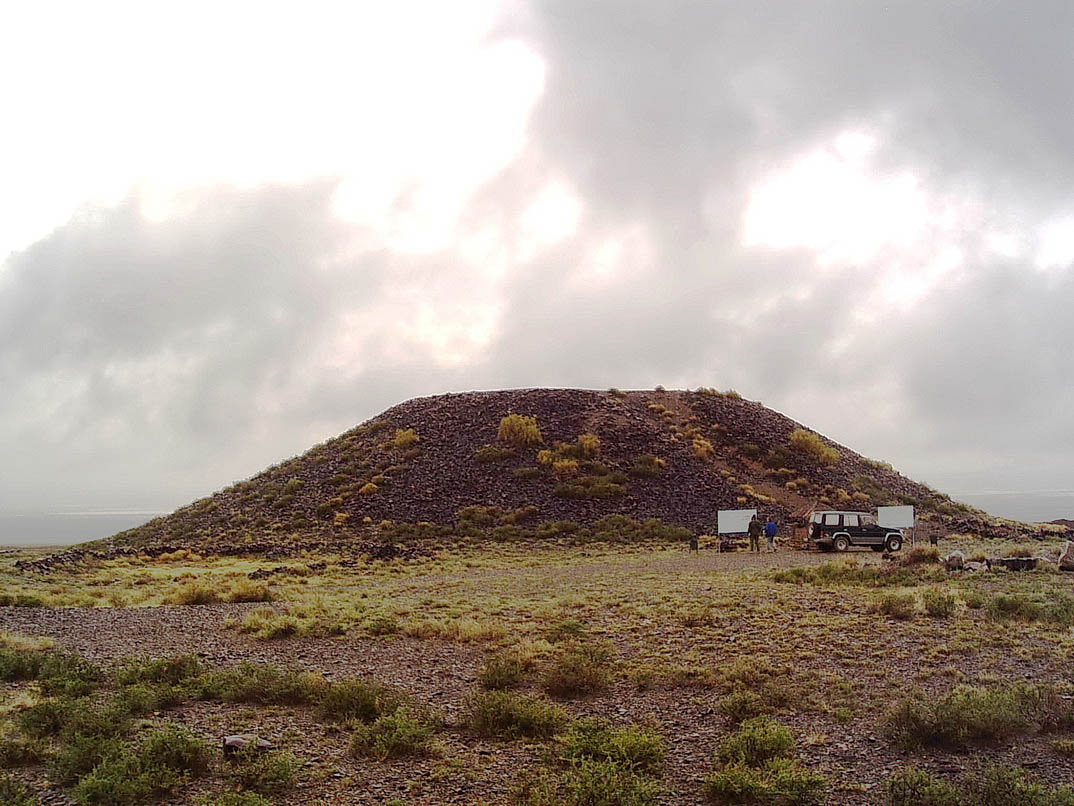  Besshatyr is
the name of the unique archeological sights also called the Imperial
burial mounds. The Saks’ headmen of the 7-3 centuries BC are buried
there. The burial mounds are surrounded by the menhir rings
resembling the well-known Stonehenge in Great Britain. There are 31
burial mounds in the Besshatyr valley. The biggest burial mound is 17
meters high and its diameter is 108 metres. In the mountain passes
there are galleries of the rock engravings representing different
animals and scenes of hunting them - there are about 45 solid rocks
covered with those petroglyphs.The river Ili is the main waterway and
the natural boarder of the Altyn-Emel nature reserve. Ili originates
in the territory of China. The river has got a mixed feeding. The
mild seasonal spring flood begins normally at the end of April. In
May there is a river flood caused by the melting of the mountain
snows and the water keeps rising up to July and August. Then the
water level falls and becomes normal in September. The river freezes
up for several months in winter.
 The river basin is divided by its
branches and tributaries separated from the main stream by little
islands that are covered with reeds, thypas, bushes and trees.The
desert climate is continental and experiences extreme seasonal
changes. The yearly precipitations level totals 300-330 mm their
prevailing volume accrues to April and May. The driest month is
September. The yearly temperatures average 4-5 degrees Celsius. The
January temperature averages -8,5 degrees Celsius, its minimum is
-29,5 degrees Celsius. The July temperature averages + 26 degrees
Celsius its maximum is +45 degrees Celsius. The time range when the
average temperature is higher than 0 degrees Celsius is about 260
days, and the period when the temperatures are higher than 10
degrees Celsius is about 186 days.
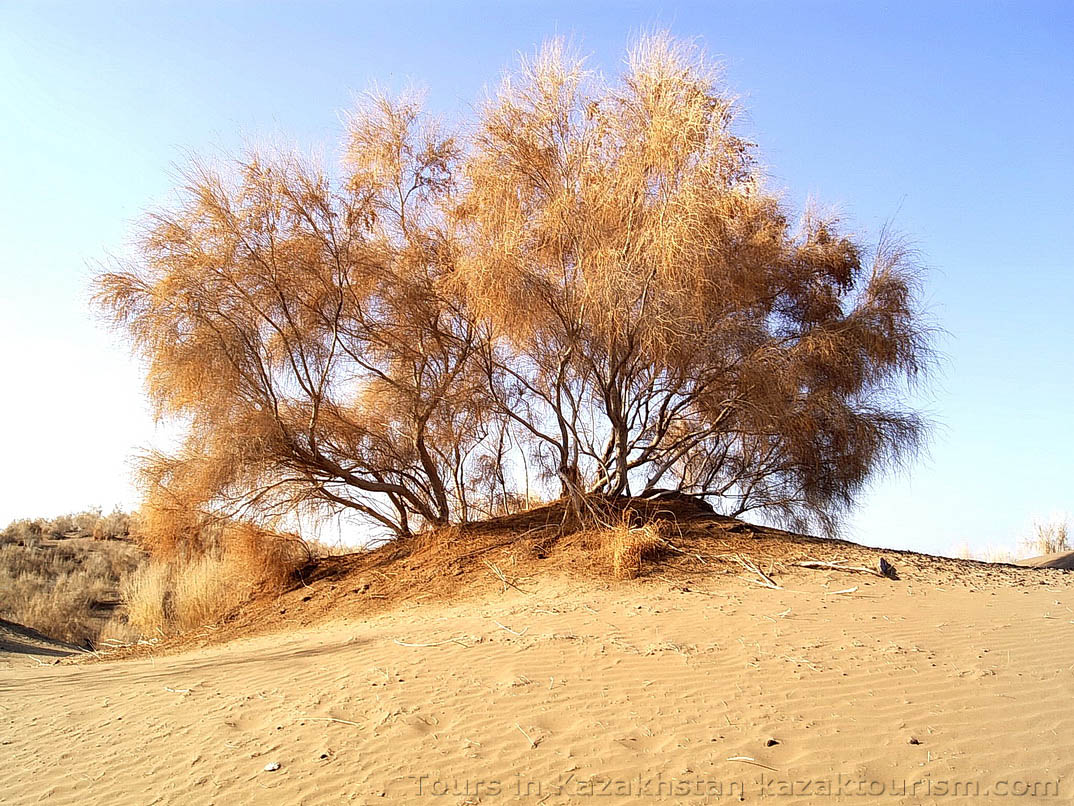 The flora of the national park
comprises about 1500 species, among them 22 rare ones included in the
list of the endangered species. The most interesting relicts are
Astragalus, Ili Ferula and some endemics like Alberta tulip,
short-stamen tulip, the Muslims’ catchfly (Silene), Ili barberry,
Chesneya dzhungarica, Aquilegia vitalii, Astragalus kopalensis,
Cachris, Silaus, Pilopleura goloskokovii and others.The majority of
plants are healthy. Many of them are eaten by the wild animals. Their
seeds and fruit are eaten by birds and some mouse-like rodents; the
branches or leaves are eaten by hooved animals. The following flora
species are especially valuable: oriental feather grass (Stipa) ,
Bromus japonicas, Atraphaxis, Salsola orientalis, Salsola arbuscula,
black saksaul, Goniolimon, Artemisia terrae-albae and others. There
are some melliferous plants (Halimodendron, camel thorn, pea tree),
ethereal-oil plants (thyme, ziziphora, dragon head), some officinal
plants etc.
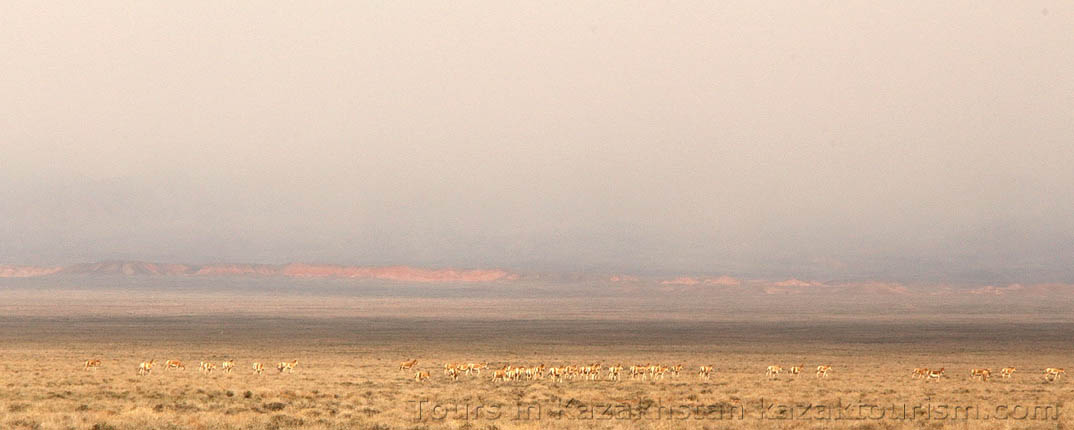 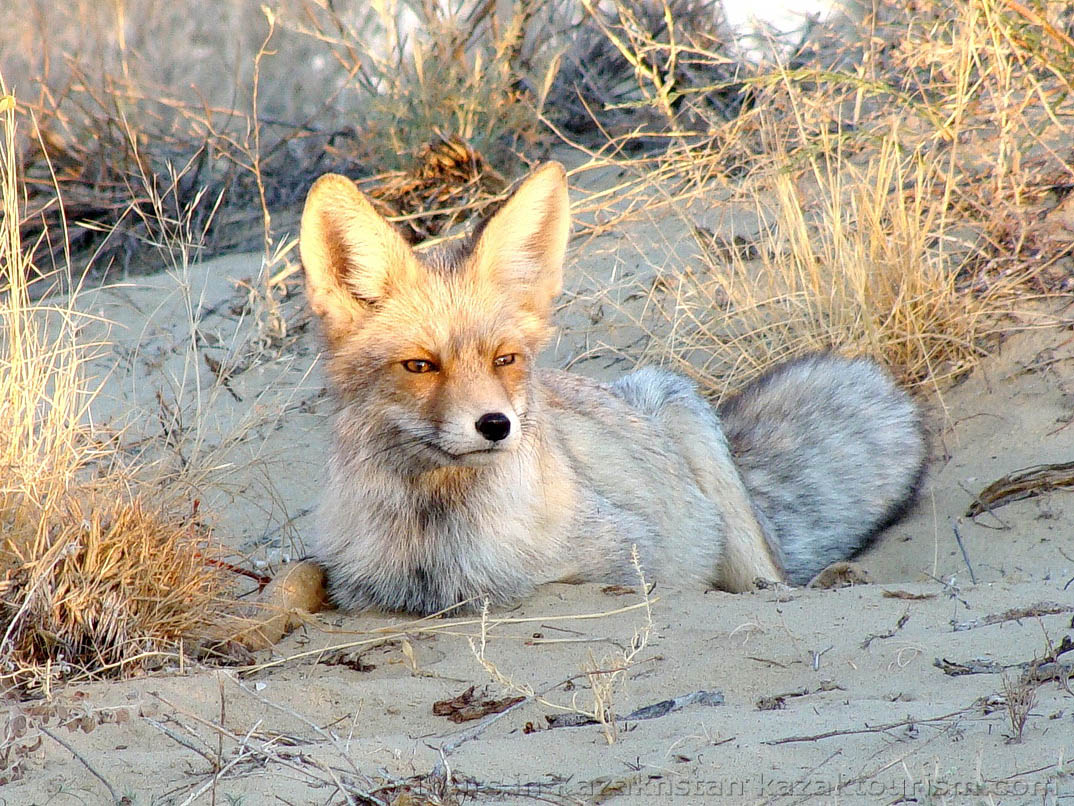 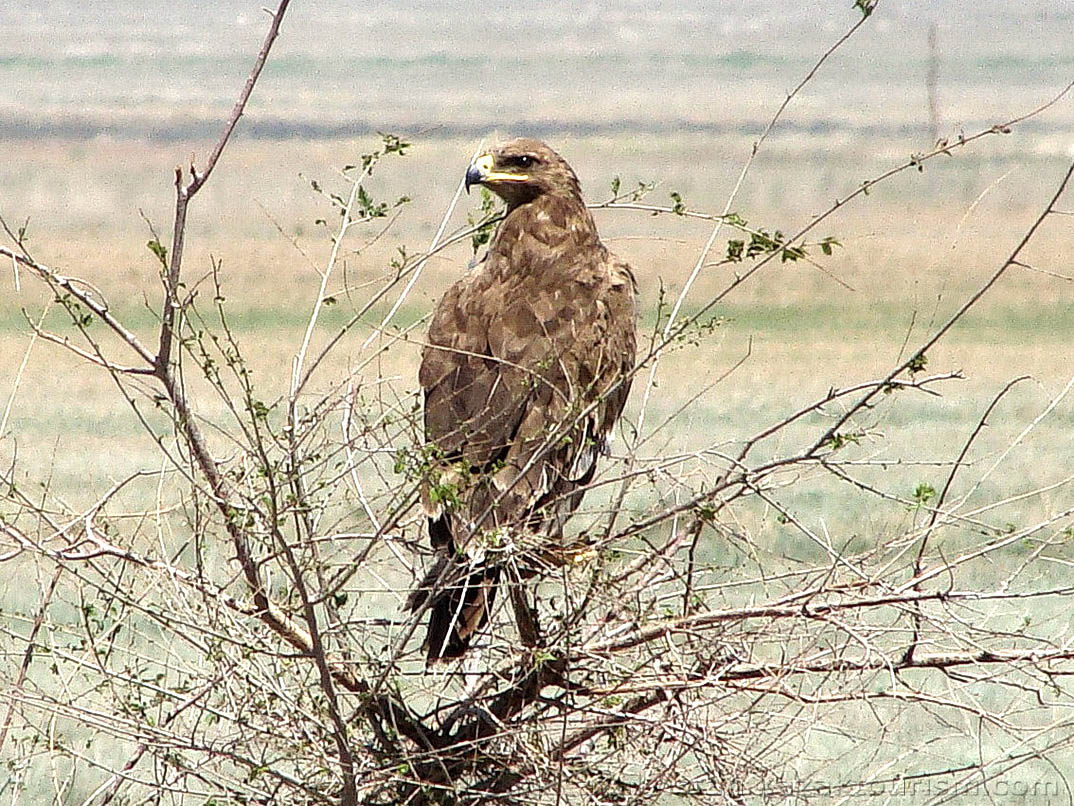 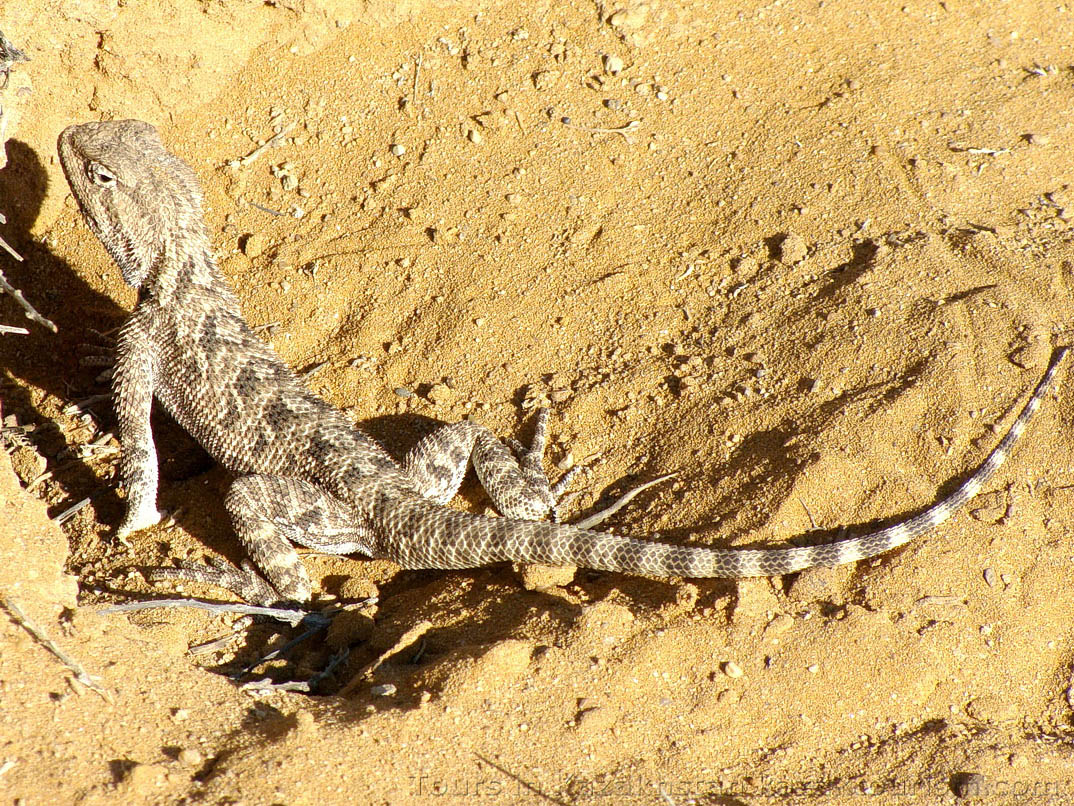 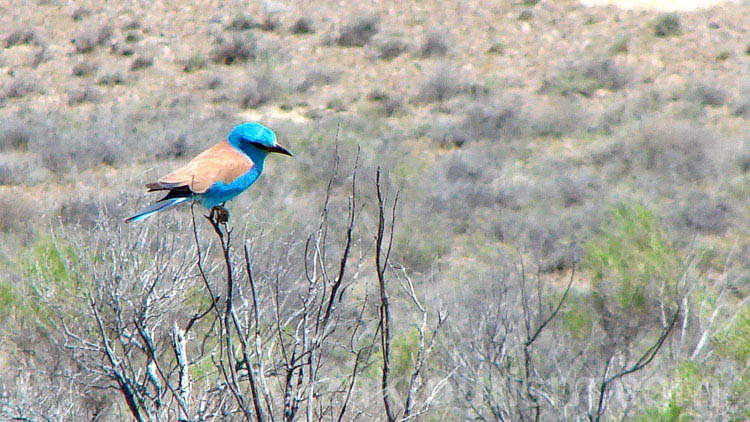 The fauna includes more than 5000 species of insects. More
than 500 species of beetles inhabit tugai
(this is how the vegetation of the river basin called). About 25
species are included in the list of the endangered species. Some
kinds of dragonflies (Calopteryx virgo, Anax imperator), praying
mantis, grasshoppers (saga pedo, black-winged grasshopper
(Ceraeocercus fuscіpennіs)), coleoptera (Carabus solskyі,
Heteroplistodus tschіtscherіnі, Ili musk beetle, anoplistes
galusoi, Hesperophanes heydeni, stethorus punctillum, Chilocorus
bipustulatus; hymenoptera (Scolia hirta, Sphex flavipennis, Prionyx
haberhaueri etc.); dipteran and lepidopterous (Catocala optima,
Otnjukovia tatjana) and others.The fauna includes also different
kinds of animals. There are about 20 fish species in Ili and
Kapchagay artificial water reserve, including 5 native species. Three
of them are endemic: the Balkhash perch, Ili marinka and plain
gubach. The other species have been naturalized (carp, Chinese carp,
silver carp, asp, catfish, bream, pike-perch, and Caspian roach. Some
rare species are: ship, Aral barb, and Ili marinka, Balkhash river
perch. There are three species of the amphibious: green toad,
Siberian wood frog, lake frog. There are 25 species of reptiles. In
the mountains inhabit Alay lidless skinks, copperhead snake, Orsini's
viper, Dione snake; in the deserts and semi deserts there are Central
Asian tortoise, sunwatcher agama, black-tailed toad agama,
plate-tailed gecko, kidney-tailed geckos, steppe agama, some species
of desert lacertas, arrow snake and others.There are about 200 birds’
species, about 174 species from them are nesting species. 18 species
are included in the list of the endangered species: black stork,
ferruginous duck, osprey, harrier eagle, imperial eagle, golden
eagle, white-tailed eagle, hooded vulture, bearded vulture, Himalayan
vulture, saker falcon, common crane, demoiselle crane, houbara
bustard, eastern stock dove, black-bellied sandgrouse, pallas sand
grouse and eagle-owl.There are about 70 species of mammals; seven of
them are included in the list of the endangered species: stone
marten, mottled polecat, Tien Shan mountain sheep, snow leopard,
Persian gazelle, Asiatic wild ass (Kulan). There are the largest
populations of Persian gazelles (4000 animals) and Siberian mountain
sheep (1500 animals) in Altyn-Emel. Also, there are 4 species of
cloven hoofed (wild boar, roe deer, saiga antelope, moufflon) and 2
species of solid hoofed animals (Kulan and Przewalski’s horse) The fauna includes more than 5000 species of insects. More
than 500 species of beetles inhabit tugai
(this is how the vegetation of the river basin called). About 25
species are included in the list of the endangered species. Some
kinds of dragonflies (Calopteryx virgo, Anax imperator), praying
mantis, grasshoppers (saga pedo, black-winged grasshopper
(Ceraeocercus fuscіpennіs)), coleoptera (Carabus solskyі,
Heteroplistodus tschіtscherіnі, Ili musk beetle, anoplistes
galusoi, Hesperophanes heydeni, stethorus punctillum, Chilocorus
bipustulatus; hymenoptera (Scolia hirta, Sphex flavipennis, Prionyx
haberhaueri etc.); dipteran and lepidopterous (Catocala optima,
Otnjukovia tatjana) and others.The fauna includes also different
kinds of animals. There are about 20 fish species in Ili and
Kapchagay artificial water reserve, including 5 native species. Three
of them are endemic: the Balkhash perch, Ili marinka and plain
gubach. The other species have been naturalized (carp, Chinese carp,
silver carp, asp, catfish, bream, pike-perch, and Caspian roach. Some
rare species are: ship, Aral barb, and Ili marinka, Balkhash river
perch. There are three species of the amphibious: green toad,
Siberian wood frog, lake frog. There are 25 species of reptiles. In
the mountains inhabit Alay lidless skinks, copperhead snake, Orsini's
viper, Dione snake; in the deserts and semi deserts there are Central
Asian tortoise, sunwatcher agama, black-tailed toad agama,
plate-tailed gecko, kidney-tailed geckos, steppe agama, some species
of desert lacertas, arrow snake and others.There are about 200 birds’
species, about 174 species from them are nesting species. 18 species
are included in the list of the endangered species: black stork,
ferruginous duck, osprey, harrier eagle, imperial eagle, golden
eagle, white-tailed eagle, hooded vulture, bearded vulture, Himalayan
vulture, saker falcon, common crane, demoiselle crane, houbara
bustard, eastern stock dove, black-bellied sandgrouse, pallas sand
grouse and eagle-owl.There are about 70 species of mammals; seven of
them are included in the list of the endangered species: stone
marten, mottled polecat, Tien Shan mountain sheep, snow leopard,
Persian gazelle, Asiatic wild ass (Kulan). There are the largest
populations of Persian gazelles (4000 animals) and Siberian mountain
sheep (1500 animals) in Altyn-Emel. Also, there are 4 species of
cloven hoofed (wild boar, roe deer, saiga antelope, moufflon) and 2
species of solid hoofed animals (Kulan and Przewalski’s horse)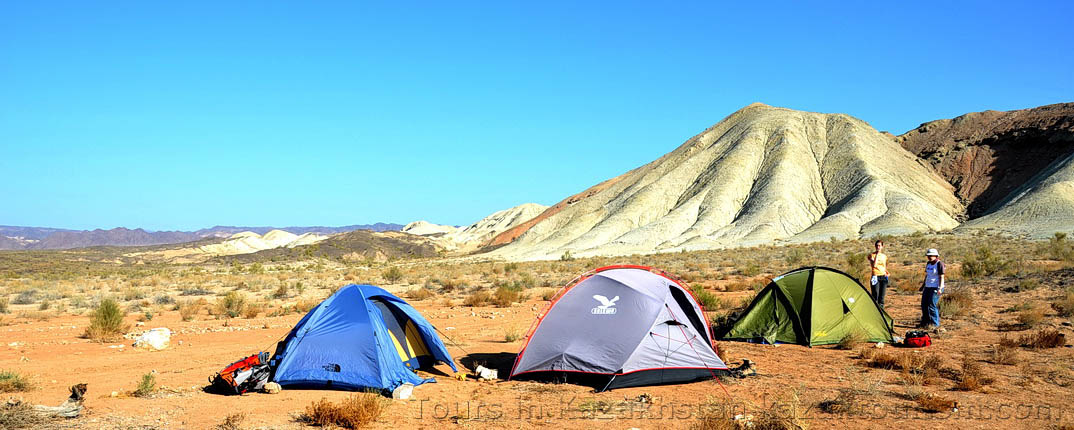 All
the variety of the wildlife and of the inanimate nature is preserved
in the national park thanks to the team members of the Altyn-Emel
national park administration. The scientific investigations on
different subjects are carried out and the nature records are kept.
The significant attention is paid to the development of the
ecotourism here. All
the variety of the wildlife and of the inanimate nature is preserved
in the national park thanks to the team members of the Altyn-Emel
national park administration. The scientific investigations on
different subjects are carried out and the nature records are kept.
The significant attention is paid to the development of the
ecotourism here.The article has been prepared using information from
the open sources.
You can find some links below containing the
detailed description of the guided tours to the National park
Altyn-Emel. The two- and three-days tours from Almaty to the
Altyn-Emel natural reserve. Altyn-Emel park is one of the most
beautiful places of the Almaty region and it is definitely one of the
best natural spots worth seeing in Kazakhstan. We wish you a nice
journey and many unforgettable impressions! |
Two days tour: Altyn-Emel national park
Three days tour: Altyn-Emel national park. Kolsay, Kaindy lakes.
Four days tour: 2 National parks - From desert to mountains
